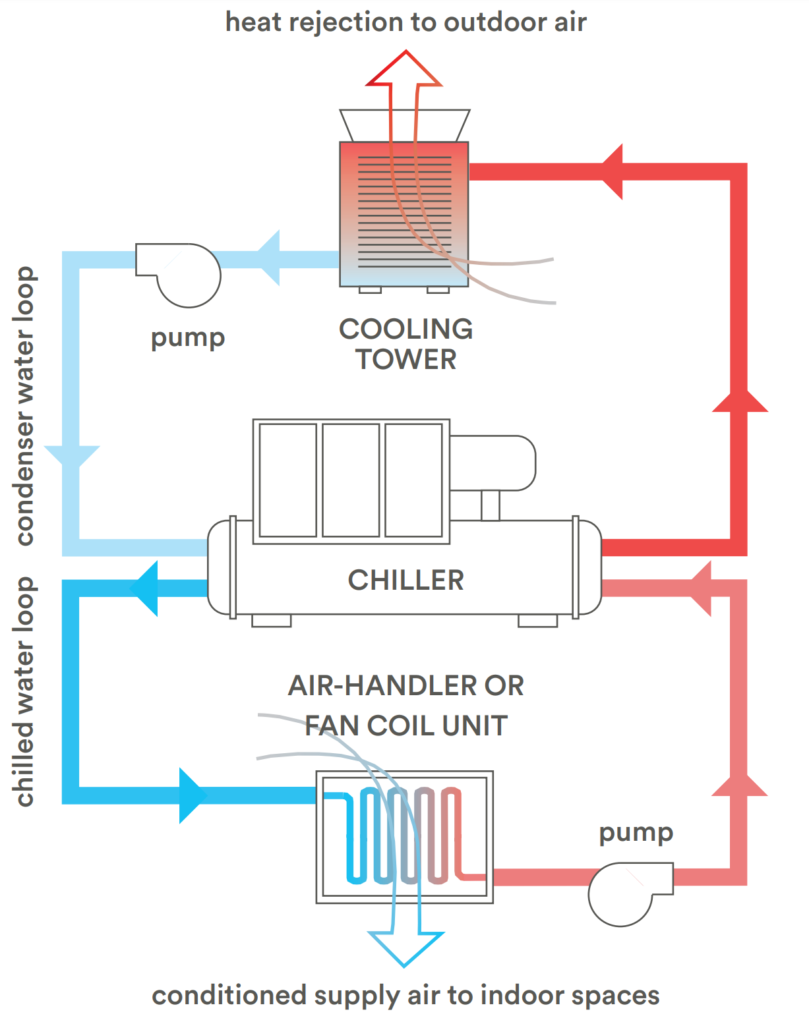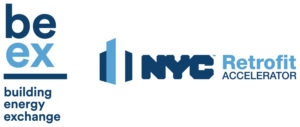Chilled Water Plant Optimization
Highly efficient centralized cooling upgrades that increase energy efficiency and savings.
Tech Overview
Applicable Buildings Types hotels, large multifamily, institutional, industrial, commercial
When to Implement at time of equipment replacement
*Be sure to consult a qualified service provider to determine the right measures for your building.
What is Hydronic Heating?
Chilled water plants use water to provide centralized cooling, and are typically found in large multi-family buildings are well as in more complex constructions. Efficiency and performance can be improved through the appropriate selection of optimization of high-performance equipment and controls.
Fig 1. Chilled water is generated by a chiller and pumped to terminal units, where air passes through the unit to condition the space. Typically, unwanted heat is rejected at the cooling tower via a condenser water loop.
How to Implement
Chilled water plants are comprised of a number of components that each contribute to the overall performance of the system. A high-performance retrofit typically includes updating chillers and terminal units, optimizing heat rejection, correctly sizing pumps, and installing smart controls. Download the full tech primer to learn more about each of the following steps:
A.Upgrade Chilling Equipment to high-performance, electric chillers or air-to-water heat pumps
B. Install High Temperature-Drop Terminal Units with as high of an entering water temperature as possible to help the whole system operate efficiently
C. Optimize Heat Rejection with cooling towers with the lowest overall size and power consumption for greatest efficiency
D. Properly Sized Water Pumps can maximize energy savings through greater efficiency and less maintenance issues than oversized pumps
E. Install Smart Controls to optimize your chilled water plant performance when centrally controlled through a building management system (BMS)
Cost and Benefits
Cost and benefits of chilled water plant optimization will vary depending on your building’s baseline systems and conditions. Typically, buildings can expect to see the following results:
Greenhouse Gas (GHG) Savings
An optimized chilled water plant greatly reduces cooling related GHG emissions.
Tenant Experience Improvement
Tenants’ everyday experience will remain largely unchanged, however, improving the overall function of teh cooling plant will provide more reliable and efficient cooling.
Utility Savings
Energy use will be reduced, but cost savings may be minimal when switching from fuel-fired to electric chillers due to current cost of electricity.
Capital Cost
A chilled water plant retrofit requires a very large capital investment and is best implemented at the time of equipment replacement.
Maintenance Requirement
Optimized chilled water plants require a moderate level of maintenance. While certain components legally require certain maintenance measures, available alternatives can help bypass these requirements.
Take Action
This information is part of more than a dozen High Performance Technology Primers prepared by the Building Energy Exchange and the Retrofit Accelerator to introduce decision-makers to solutions that can help them save energy and improve comfort in their buildings. Curious about other retrofitting possibilities? Explore our complete library of Tech Primers here.
The NYC Retrofit Accelerator’s team of Efficiency Advisors offers free, personalized advisory services to help streamline the process of making energy efficient improvements to your buildings.
Get in touch with the NYC Retrofit Accelerator today!
Call (212) 656-9202
Visit nyc.gov/RetrofitAccelerator
Email info @nycretrofit.org
